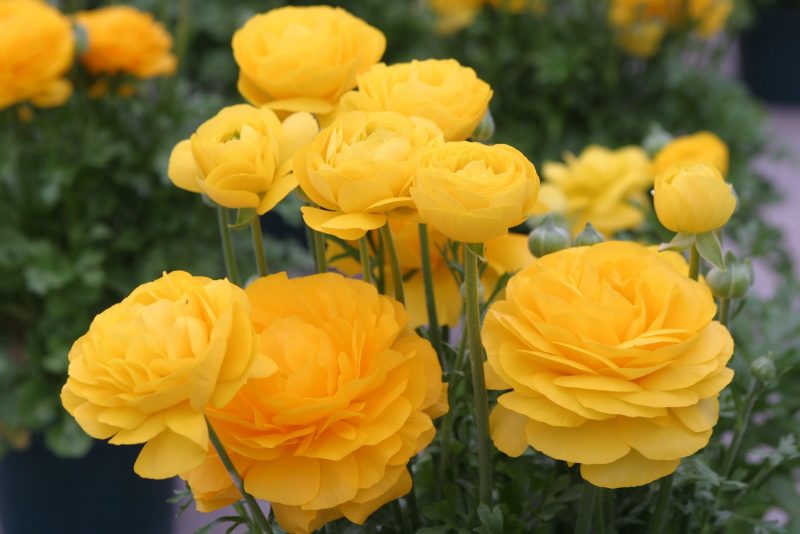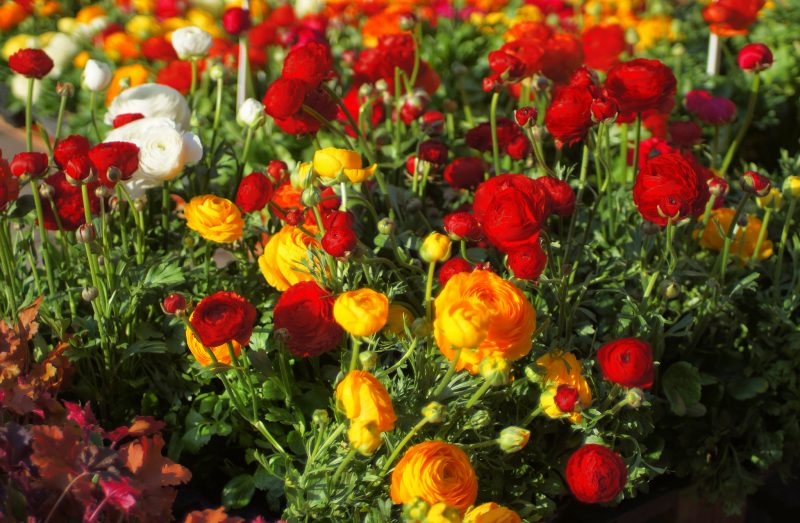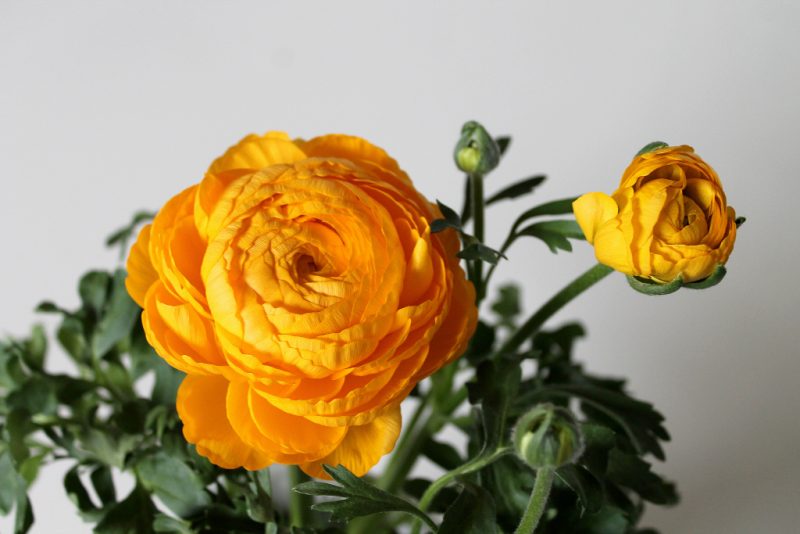Among the variety of garden flowers, many are especially cute with charming buttercups. Bright, catchy, they have been familiar to many since childhood, but today breeders have bred varieties with such a rich color scheme that it is difficult to guess the same, cute flower in them. Planting and caring for garden buttercups do not cause much difficulty, but in the end this perennial plant thanks its owner for a long flowering and bright colors.
Material Content:
Species and varieties
The botanical name of the garden buttercup is ranunculus, and in floriculture there are only two main varieties of these lovely flowers.

- Asian or Persian. This variety of buttercups can reach 40 cm in height. The flowers are very beautiful, terry, reminiscent of roses. Their coloring can be the most diverse. The plant has a corm instead of roots, in which it stores nutrients for the winter. In cold weather, the aerial part of the flower disappears.
- Chalmovidnye or African. These buttercups have larger foliage, and their flowers are distinguished by unusual petals. In African varieties, they are strongly bent inward, so that the flowers are very similar to peonies.
Based on these two varieties, a huge number of various types of buttercups were bred. Among them are many-flowered, caustic, creeping, water, burning and many others. Buttercup flowers with yellow petals are common in our culture areas. They are also often used for treatment in quackery.
Growing plants from seeds
Even in the midland, you can independently collect the buttercup seeds. To do this, leave the very first color on the bush and wait until the seeds ripen. In a box there can be up to 500 pieces.

After collecting, the seeds are dried, sorted and stacked in a paper envelope, where the material is stored all winter. It is desirable that the temperature in the room was not higher than 15 degrees.
When sowing buttercups, it is very important to use seeds only last year, since they very quickly lose their germination. For this reason, when purchasing planting material in a store, the release date on the packaging should be checked.
Garden buttercups are sown either in containers, or immediately in open ground. But it is advisable to plant a mini-greenhouse above the flowerbed when sowing in the garden.
- The soil for sowing should be loose, necessarily fertile, light.
- The soil before sowing should be shed with a weak solution of manganese to prevent infection of the sprouts.
- Sow in the garden with the first warm days.
Under indoor conditions, buttercups can be sown with the arrival of the first sunny days in March. It is advisable to grow them through seedlings in regions with a cool climate, so that the tubers have time to ripen before the autumn dig.
- To grow seedlings, the container is filled with soil mixture and it is well leveled.
- It is optimal if the seeds are spread out on the surface of the earth by the piece. Between them should remain about 1.5 cm.
- After sowing, the seeds are sprinkled with a thin layer of soil and sprayed from the sprayer planting.
- It is important not to spill the soil before sowing. Water the seeds only after they are covered with soil.
- After spraying the planting, you need to tighten the film to create a greenhouse effect.
The culture does not like heat, therefore, the optimum temperature for seed germination is + 15ºС. The first couple of weeks it is advisable to keep the temperature at about + 12ºС. Under such conditions, seedlings will appear a little later, but the shoots will be hardened.
It takes a lot of light to germinate, so keep the container in the sun. Daily planting air. It is very important to illuminate the sprouts, as buttercups need a long daylight hours.
How to plant garden buttercups in open ground
When a pair of true leaves appear on the sprouts, they are dived into separate pots for growing. In the first year, with the onset of really warm days, seedlings are transferred to the garden. Expect flowering in the same season from such plants is not worth it. They simply develop all summer, in the fall they dig up tubers, and next year the bushes will bloom.

How to plant buttercups correctly so that they quickly acclimatize in the new environment?
- Usually in the middle lane flowers are planted on a flowerbed at the end of May.
- When choosing a site for planting, it should be borne in mind that buttercups love high humidity, but at the same time they can not stand stagnation of moisture at the roots. Therefore, the site should be on a hill so that all excess moisture goes into the ground.
- Seedlings are planted in deep holes with drainage arranged at the bottom. You can carry flowers in a pot of peat, in which seedlings grew.
- They leave the previous level of deepening, trying not to destroy the earthen lump around the roots during planting.
- The earth is immediately compacted and shed.
- If necessary, add soil.
Garden Flower Care
This culture requires intensive, painstaking care. Do not do without fertilizing. For these purposes, phosphorus-potassium compounds are added once every two weeks. It is also beneficial for buttercups to add wood ash.

Watering should be carried out sparingly, keeping the soil slightly moist. In no case should the soil be completely dry.
Faded flowers are removed, weeding is carried out regularly, they are combined with loosening the soil.
Breeding methods
The easiest way to propagate these flowers is to divide the root. So you can get several bushes at once.

The seed method is often used by breeders to breed new varieties and species. To divide the root, the bush is dug up and divided into several divisions, and then immediately transplanted to a new place. Buttercups give quite a lot of baby roots, which are separated from the mother bush and then transplanted.
Forcing garden buttercups
Growing buttercups is a very exciting activity that you can do in winter. Observing all the conditions of distillation, you can make the buttercup bloom in 3 months. Therefore, the planting period directly depends on the planned date of receipt of flowers. Typically, distillation is carried out from August to November.
- For distillation, a plant is planted in garden soil, which is mixed in equal parts with humus and sand.
- The tubers are placed with their horn down and deepened by 3 cm.
- Top planting is covered with soil.
- If the nodules are slightly dried, they must be soaked in the Epina solution before planting for a couple of hours.
In room conditions, it is important to observe the temperature during distillation. It is desirable that the room was + 10ºС when planting and not higher than + 20ºС during the growth period. At high temperature, the stems stretch very much and lose their decorative effect.
How to store tubers in winter
Tubers are dug up already in September, when the flowers dry up and the stems wither. The rhizomes of these plants are very fragile, and therefore it is necessary to dig up tubers and clean them from the soil with extreme caution.

On the rhizomes of buttercups there are usually many children who carefully separate. For disinfection, they are placed in the “Fundazole” solution for 30 minutes, after which they are well dried in the shade for 4 days.
Dry corms are best stored in winter in paper bags or in cloth bags. Many gardeners store planting material in dry moss or peat. The main thing is that the tubers are dry and cool. In a private house, a basement is quite suitable for such purposes.
Throughout winter at least once a month, nodules are taken out and inspected for damage.
If bulbs affected by a fungus are found, they are treated with brilliant green. Nodules that are too eaten by mold and fungus are thrown away so that they do not infect healthy specimens.
With the advent of spring, planting material is taken out and sorted out. Cured and diseased tubers are discarded and begin to prepare healthy bulbs for planting.
Buttercups are garden plants of amazing beauty, which will certainly become the main decoration of a summer flower bed.












